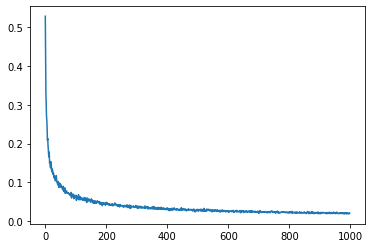Let $z_1,z_2,\dots,z_n$ be $n$ complex numbers distributed uniformly and randomly over the unit disc $x^2+y^2 \leq 1$. Let $z$ be the complex number defined by the mean of the of these numbers,that is,
$$ z=\frac1n \sum_{i=1}^{n} z_i.$$
Numerical simulations reveal that $E(|z|)$ exists. I want to know if there is some analytical way of finding a closed form expression for the expected radial distance of $z$ in terms of $n$? Any hints/responses will be greatly appreciated . The graph shows the variation of $E(|z|)$ with $n$ 
-
$\begingroup$ This seems like a difficult version of an "expected distance of random walk from the origin" type of result, but I can't find a clearly related result. Usually the length of each step is fixed (here, it is random), and only the direction is random. $\endgroup$– SteveCommented Jun 9, 2021 at 8:54
-
$\begingroup$ The value for $n=1$ is $\frac{2}{3}$, which can be shown by solving a two-dimensional integral. Solving the 4-dimensional integral for $n=2$ should be withing reach, perhaps. $\endgroup$– Moritz FirschingCommented Jun 9, 2021 at 11:59
-
1$\begingroup$ For $n=1$ it is simply $\int_0^1 \sqrt{x} dx = 2/3$ because the direction does not matter and the distance from zero of each $z_i$ is distributed as the square root of a uniformly distributed random variable on $[0, 1]$. The case $n=2$ seems much harder. $\endgroup$– SteveCommented Jun 10, 2021 at 6:51
-
$\begingroup$ I calculated numerically the value for $n=2$ and I have a conjecture as to what the exact value might be: mathoverflow.net/q/395659 $\endgroup$– Moritz FirschingCommented Jun 18, 2021 at 12:35
-
$\begingroup$ Along the same lines as Kluyver,"A local probability problem" (1906), one can derive that $|\sum_{i=1}^n z_i |$ has density $\rho(x) = \frac{1}{2\pi} \int_0^\infty dt\, t\,J_0(x\, t) ( 2J_1(t) / t)^n$. $\endgroup$– Timothy BuddCommented Jun 18, 2021 at 15:45
2 Answers
Here is another method.
Since the uniform distribution on the unit disk is rotationally symmetric (invariant under orthogonal transformations), the problem can be reduced to a random walk problem in $\mathbb{R}$.
Let $Z_1,Z_2,\ldots$ be independent, and identically uniformly distributed on the unit disk, with $Z_i=(X_i,Y_i)$. Clearly $X_1,X_2\ldots$ are i.i..d with density $p(x)=\frac{2}{\pi}\sqrt{1-x^2}1_{[-1,1]}(x)$.
For any rotationally symmetric random vector $V=(V_1,V_2)$ with finite expectation of $|V|:=\sqrt{V_1^2+V_2^2}$ it holds that $$\mathbb{E}(|V|)=\frac{\pi}{2}\mathbb{E}(|V_1|)$$ Applying this to $Z^{(n)}:= |Z_1+\ldots+Z_n|$ we get that
\begin{align*} \mathbb{E}\big(\frac{Z^{(n)}}{n}\big)&=\frac{1}{n}\frac{\pi}{2}\mathbb{E}|X_1+\ldots + X_n|\\ &=\frac{1}{n}\big(\frac{2}{\pi}\big)^{n-1}\,\int_{-1}^1\ldots\int_{-1}^1|x_1+\ldots+x_n|\prod_{i=1}^n\sqrt{1-x_i^2}\,dx_1\,\ldots dx_n\\ \end{align*}
The integrals can be solved explicitly for $n=1$ and $n=2$, but that seems to be as far as it goes. But (using the central limit theorem and uniform integrability) it is easy to see that $$\mathbb{E}\big(\frac{Z^{(n)}}{\sqrt{n}}\big)\longrightarrow \sqrt{\frac{\pi}{8}}$$
Remarks:
(1) a related problem appeared here An interesting triple integral
(2) for similar considerations see Feller II (1971), p. 30 ff
-
$\begingroup$ @sajjad veeri: for $n=3$ see my answer to the follow-up post by Moritz Firsching. $\endgroup$– esgCommented Jun 25, 2021 at 18:51
This does not answer the question, but reformulates it as an integration problem and addresses a question asked in the comments. Conditionally on $|z_1| = a_1$, ..., $|z_n| = a_n$, the probability that $x<c$ was computed in Kluyver, "A local probability problem" (1906) to be $$ \mathbb{P}\Big( \big|\sum_{i=1}^n z_i\big| < c \,\Big|\, |z_i|=a_i \Big) = c \int_0^\infty J_1(uc)\prod_{i=1}^n J_0(u a_i)\,\mathrm{d}u. $$ Using that $\int_0^1 2a\,J_0(u a) \mathrm{d}a = 2 J_1(u) /u$ and $\frac{\partial}{\partial c}( c J_1(u c)) = uc J_0(u c)$, this gives the density as $$ \rho(x) = \frac{\partial}{\partial x}\mathbb{P}\Big( \big|\sum_{i=1}^n z_i\big| < x\Big) = \int_0^\infty xu J_0(ux) \,\left(\tfrac{2}{u}J_1(u)\right)^n\mathrm{d}u. $$ (Note: there was a small mistake in the formula given in the comments.) By construction $\int_0^n\rho(x)\,\mathrm{d}x = 1$ as $\rho(x)$ vanishes for $x > n$. Hence \begin{align} \mathbb{E}\Big( \frac{1}{n}\big|\sum_{i=1}^n z_i\big|\Big) &= \frac{1}{n} \int_0^n \mathrm{d}x \int_0^\infty \mathrm{d}u\, x^2u\, J_0(ux) \left(\tfrac{2}{u}J_1(u)\right)^n \\ &= \frac{n^2}{3} \int_0^\infty u\,{_1F_2}(\tfrac{3}{2};1,\tfrac{5}{2}; -\tfrac14 n^2u^2) \left(\tfrac{2}{u}J_1(u)\right)^n, \end{align} where the second integral was kindly provided by mathematica.
One could hope to extract some exact values for $n\geq 3$ from Borwein, Jonathan M. "A short walk can be beautiful." Journal of Humanistic Mathematics 6, no. 1 (2016): 86-109.
-
$\begingroup$ From the above answers and comments ,we can conclude that the average of centre of mass of all n-gons for large n approaches origin .Can it admit of some geometrical or physical proof? $\endgroup$ Commented Apr 13, 2022 at 17:42
